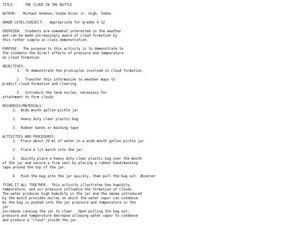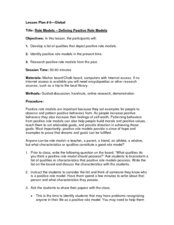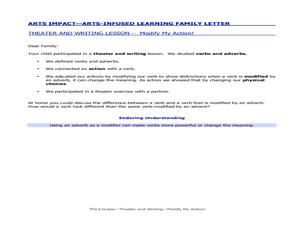Curated OER
Pop-it...Stop-it
Students observe how certain geometric shapes can be used to make some structures rigid and others flexible. The activity involves construction of a 30-60 right triangle, folding while following directions, and identifying polygons.
Curated OER
Composting
Using 2-liter bottles, junior ecologists create composting tubes in which they place nitrogen-rich and carbon-rich materials. They observe what changes occur over two weeks' time. Provide more specific direction to your class as to what...
Curated OER
The Abiotic Limits to Purple Loosestrife Growth
Young scholars investigate the effects of soil temperature, water availability, photo period and other variables of the growth of purple loosestrife. They observe the growing conditions of plants and alter them by adding water, isolating...
Curated OER
Germination
Students observe the growth of a seed into a plant. They plant their own seeds and record the growth of the plants and write about what they observe. They describe the germination of the seed and create a time line of the growth process...
Curated OER
Buoyant Behavior
Combine science and literature with this instructional activity on buoyancy. Read There's an Ant in Anthony by Bernard Most to examine words containing the letters a, n, and t. Then introduce your class to the word "buoyant."...
Denver Art Museum
From the Hat’s Point of View
Here is a lesson designed for pre-schoolers and kindergartners that will pique their imaginations. They study images of a very interesting ceremonial hat from China's past called a Summer Official's Hat. These hats were worn by people of...
Curated OER
Drama-Dialogue
Use drama to study and practice dialogue. Creative minds discuss what dialogue tells about a character, and how it can be used to advance the plot. They read a play, think about what they gleaned from dialogue, and record their...
Curated OER
"Tis The Season" Bulletin Board
Students explore a variety of objects which represent the various seasons as a preparation for writing about their birthday and the season in which it is located.
Curated OER
Come To Your Senses
Write narratives that include ideas, observations, or memories of an event or experience, and be sure to use concrete sensory details! Groups utilize a few of the famous I Spy books in order to create narratives that utilize sensory...
Curated OER
Water Changes and Moves
Students explore the three forms of water and observe how it changes from a solid to a liquid to a gas. The concepts of condensation, evaporation and the introduction to the water cycle form the basis of this lesson.
Curated OER
Art Self-Assessment
Reflection is a wonderful way to understand yourself as a learner or as an artist. Kids write a one-paragraph analysis of their own self-portrait. They focus on style, character traits, and self characterization.
Curated OER
Aerospace/Aeronautical Engineering: Build a Paper Airplane
Students brainstorm what it is like to fly on an airplane and discuss the parts of a plane. Students construct a paper plane of their own, decorate it, have a competition, and discuss the importance of each part of a plane and the role...
Curated OER
Magnificent Microscopes Unit Including Mystery and Alternative Assessment Activity
After drawing and labelling a microscope, forensic science explorers use one to solve a simulated murder mystery. They examine each piece of evidence and draw what they observe at each magnification. Working in groups of four, your...
Andrea Mulder-Slater
Happy Accidents Painting
A person can see a lot of different things when he looks at the amorphous clouds. The same is true when you let your watercolor paints do as they please. Little artists create haphazard art with watercolors, then use ink or marker to...
Oregon Museum of Science and Industry (OMSI)
DNA Extraction
What does your DNA actually look like? Use simple materials with this experiment to find out! Geneticists of all ages can follow these instructions to extract their own DNA. For learners who are hoping to extend the activity, there are...
Curated OER
Applying Character and Setting to Play Readings
Read Ira Sleeps Over, then identify elements of plays that are also common to books. Learners analyze character and setting, consider how these elements relate to a play, then write a one-paragraph skit using the characters from Ira...
Curated OER
The Cloud in the Bottle
Students observe a demonstration of how pressure and temperature affects cloud formation.
Curated OER
Fractions and Paper Folding
In this fraction lesson plan, students manipulate paper by folding it to create different shapes and sizes, they explore the concept of fractions, and discuss their observations as a class. This is a great lesson plan for getting...
Curated OER
Role Models - Defining Positive Role Models
Being able to identify what characteristics make a good role model is one way for students to better understand their own positive behaviors. The class brainstorms what characteristics make up a good role model, research a role model...
Curated OER
Writing About Winter
Students explore the characteristics of winter and use invented spelling processes to describe their observations. A word wall is utilized to assist the learner through the independent writing exercises.
Curated OER
Indian Basket Weaving
Students explore Indian Basket designs, experiment with weaving materials and create their own baskets in this 5-day Arrt lesson for the early-elementary classroom. The lesson includes scoring guides and illustrated directions for students.
Curated OER
Forming Words
Young readers observe some examples on the board to show them what they are to do to form compound words and to form words by putting together the first part of the word with the last part. They practice the concept by completing the...
Curated OER
Modify My Action
Third graders listen to directions as they perform a theatrical role. In this vocabulary lesson, 3rd graders listen to and observe the adjectives given to them during a practice of their performance by the director. Students...
Curated OER
Inherited Traits
Students work with a partner to complete an inventory of their traits and compare and discuss their unique qualities. In this biology lesson, students determine percentages for the frequency of observed traits of classmates, compile the...























